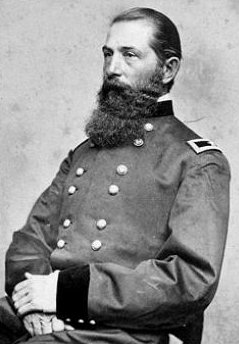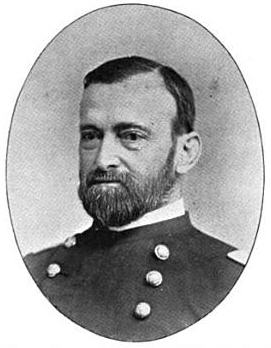
John Michael Tobin was an officer in the Union Army who received the Medal of Honor for his actions at the Battle of Malvern Hill during the American Civil War.

Charles Bradley Stoughton was an officer and regimental commander in the Union Army during the American Civil War.

David Allen Russell was a career United States Army officer who served in the Mexican–American War and the American Civil War. He was killed in action as a brigadier general in the Union Army.

Charles Russell Train was an American lawyer and politician who served two terms as a U.S. Representative from Massachusetts from 1859 to 1863.

Joseph Pope Balch was an American businessman from Rhode Island who served as an officer in the Union Army during the early months of the American Civil War.

Samuel Breck was an officer in the United States Army who served as Adjutant General of the U.S. Army from 1897 to 1898.

William Schouler was an American journalist, politician and Adjutant General of Massachusetts during the American Civil War.

Arthur Forrester Devereux was a captain in the Massachusetts Volunteer Militia prior to the Civil War and a colonel in the Union Army during the Civil War. He is notable for his expertise and proficiency in the instruction of military drill. During the Battle of Gettysburg, the 19th Massachusetts Infantry, under his command, played an important role in filling a breach in the Union lines during Pickett's Charge. After his active service had concluded, Devereux was awarded the honorary rank of brevet brigadier general, United States Volunteers, by appointment of President Andrew Johnson on February 21, 1866, to rank from March 13, 1865, and confirmation by the U.S. Senate on April 10, 1866.

The 7th Regiment Massachusetts Volunteer Infantry was an infantry regiment in the Union army during the American Civil War. It was formed on June 15, 1861, in Taunton. Its original commander was Colonel Darius N. Couch who would eventually be promoted to command the II Corps of the Army of the Potomac and, after that, the Department of the Susquehanna.

The 12th Regiment Massachusetts Volunteer Infantry was an infantry regiment in the Union army during the American Civil War. It was formed on June 14, 1861, in Boston, Massachusetts. Its original commander was Colonel Fletcher Webster, son of the famed U.S. Senator from Massachusetts, Daniel Webster. The unit was known as the Webster Regiment after its first colonel.

The 13th Regiment Massachusetts Volunteer Infantry was an infantry regiment in the Union Army during the American Civil War. It was formed on July 16, 1861, at Fort Independence in Boston, Massachusetts. Its original commander was Colonel Samuel H. Leonard.
The 5th Regiment Massachusetts Colored Volunteer Cavalry was a cavalry regiment from Massachusetts, that served in the Union Army during the American Civil War.
Camp Edwin M. Stanton was an American Civil War training camp that existed from 1861 to 1862 in Lynnfield, Massachusetts. When the camp first opened in 1861 it was known as Camp Schouler, named for Massachusetts Adjutant General William Schouler. In some references it is misspelled as Camp Schuyler. After President Abraham Lincoln's call for 300,000 troops in July 1862, the camp was revived and renamed in honor of United States Secretary of War Edwin M. Stanton. It served as the training camp and rendezvous for recruits from eastern Massachusetts. The camp trained ten infantry regiments and four artillery batteries of the Massachusetts militia, including the 17th, 19th, 22nd, 23rd, 33rd, 35th, 38th, 39th, 40th, and 41st regiments of infantry and the 3rd, 5th, 9th, and 10th batteries of light artillery. Soldiers stationed at Camp Schouler/Stanton during training included Edward A. Wild, Henry Wilson, Nelson A. Miles, Edward Winslow Hinks, and Arthur F. Devereux. During World War I it was renamed Camp Houston and served as a Massachusetts National Guard mobilization camp in 1917. It was located on the Newburyport Turnpike near the Peabody, Massachusetts line. The camp was divided into streets, with tents and cook houses located on both sides of the Turnpike to Suntaug Lake.
Marcus M. Haskell was an American soldier who fought in the American Civil War. He received the Medal of Honor, the highest military award, for rescuing a wounded man while under fire at Antietam, on 17 September 1862, in spite of his own wound.

24th Regiment Massachusetts Volunteer Infantry was an infantry regiment in the Union army during the American Civil War. It was organized around September-December 1861 at Camp Massasoit in Readville, under Col. Thomas G. Stevenson. The regiment served with the Coast Division commanded by Maj. Gen. Ambrose Burnside. The Coast Division was deployed in January 1862 for operations on the coast of North Carolina, and participated in the Battle of Roanoke Island and the Battle of New Bern among other engagements.

The 17th Massachusetts was an infantry regiment that served in the Union Army during the American Civil War.

The 8th Regiment Massachusetts Volunteer Militia was a peacetime regiment of infantry that was activated for federal service in the Union Army for three separate tours during the American Civil War. The regiment consisted almost entirely of companies from Essex County, Massachusetts. The Cushing Guards, established 1775, were Company A based in Newburyport. The Lafayette Guards, created 1825, were Company B from Marblehead. Company C, the Sutton Light Infantry, organized in 1805 as the Marblehead Light Infantry, was also from Marblehead. The Lynn Light Infantry, chartered in 1852 was Company D. Company E was the Beverly Light Infantry, organized in 1814. The second Lynn company was Company F, the City Guards, organized in 1814. The Gloucester unit in the regiment was Company G, the American Guards, first organized in 1788. The third and last Marblehead company was H, the Glover Light Guards, created in 1852 and named in honor of John Glover of the Revolution. The Salem Light Infantry, Company J, had been created in 1805 and in 1859 had taken up Zouave drill and were thence known as the Salem Zouaves. The lone non-Essex company was Company K, the Allen Guards, created in 1806, that came to the regiment from Berkshire County's reorganized old Tenth Militia regiment, and based in Pittsfield.

The 4th Massachusetts Battery was an artillery battery that served in the Union Army during the American Civil War. The unit was sometimes known as "Manning's Battery" after its commanding officer, Capt. Charles H. Manning. It was one of the Massachusetts regiments organized in response to President Abraham Lincoln's call on May 2, 1861 for volunteer troops to serve a term of three-years. The core of the unit was a peace-time militia company known as the Salem Light Artillery. The battery trained at Camp Chase in Lowell, Massachusetts. It was assigned to the Department of the Gulf under Major General Benjamin F. Butler and departed Boston by steamship on November 20.

The 5th Massachusetts Battery was an artillery battery that served in the Union army during the American Civil War. It was one of the Massachusetts regiments organized in response to President Abraham Lincoln's call on May 2, 1861 for volunteer troops to serve a term of three-years. The battery trained at Camp Shouler in Lynnfield, Massachusetts and Camp Massasoit in Readville, Massachusetts. It departed Boston by steamship on December 25, 1861.

The 11th Massachusetts Battery was an artillery battery that served in the Union Army during the American Civil War. It was formed in response to President Abraham Lincoln's August 1862 call for 300,000 men to serve for nine months. Several months after completing their first term of service, the battery was reorganized for a second term of three years. It was recruited by Captain Edward J. Jones of Boston and consisted almost entirely of men from that city. The battery served a largely uneventful first term as garrison troops mostly in Centreville, Virginia. During their second term they were involved in heavy combat being part of the Army of the Potomac during Lieutenant General Ulysses S. Grant's Overland Campaign.













